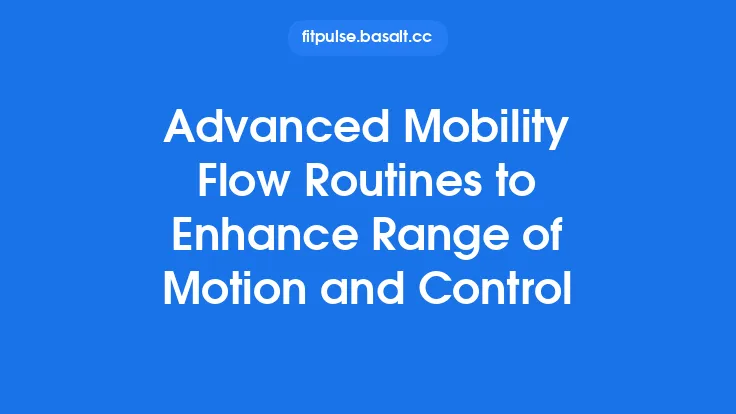Improving range of motion (ROM) is a cornerstone of a well‑rounded fitness regimen, yet it is often overlooked in favor of more visible outcomes such as strength or endurance. When mobility and flexibility are deliberately programmed, athletes and recreational exercisers alike experience smoother movement patterns, better joint health, and a heightened capacity to perform a broader array of exercises with proper technique. This article explores how to design custom mobility‑focused programs that align with specific fitness objectives, offering a systematic approach that can be adapted to any training context.
Understanding Mobility vs. Flexibility
Mobility refers to the ability of a joint to move through its full range of motion under load, integrating muscular, capsular, and neural components. Flexibility, on the other hand, describes the extensibility of a muscle or series of muscles. While the two concepts overlap, a truly mobile joint requires both adequate flexibility and the strength to control movement throughout the range. Recognizing this distinction is essential when selecting exercises and structuring progressions.
Defining the Objective: Why Customization Matters
A generic “stretch‑and‑roll” routine may yield modest improvements, but it rarely addresses the nuanced demands of an individual’s training goals. Customization begins with a clear objective, such as:
- Enhancing squat depth for powerlifting
- Increasing shoulder external rotation for overhead pressing
- Improving hip extension for sprint mechanics
- Optimizing thoracic extension for better posture during long‑duration activities
Each goal dictates a distinct set of joints, muscle groups, and movement patterns that must be targeted. By aligning the mobility program with the primary performance aim, practitioners can allocate time efficiently and achieve measurable gains.
Step‑One Assessment: Mapping the Mobility Landscape
A data‑driven assessment provides the baseline from which progress can be measured. The following tools are commonly employed:
| Assessment Tool | Primary Focus | Typical Protocol |
|---|---|---|
| Passive ROM Goniometer | Joint angle limits | Measure hip flexion, shoulder internal rotation, etc. |
| Functional Movement Screen (FMS) – Deep Squat & Hurdle Step | Integrated mobility & stability | Score each movement on a 0‑3 scale |
| Active Straight‑Leg Raise (ASLR) | Hamstring extensibility & neural tension | Record maximal angle without compensation |
| Shoulder Mobility Test (Apley Scratch) | Combined shoulder flexion/extension | Measure distance between hands |
| Thoracic Extension on Foam Roller | Segmental thoracic mobility | Quantify vertebral displacement |
Documenting these values creates a “mobility map” that highlights deficits relative to the desired performance outcome. For instance, a powerlifter aiming to increase squat depth may discover limited ankle dorsiflexion (≤ 10°) and thoracic extension (≤ 2 cm), guiding the selection of targeted interventions.
Designing the Program Architecture
1. Periodization of Mobility Work
Just as strength training benefits from macro‑, meso‑, and micro‑cycles, mobility programming can be periodized to avoid plateaus and maintain stimulus novelty.
- Macro‑cycle (12‑24 weeks): Define the overarching ROM goal (e.g., +15° ankle dorsiflexion).
- Meso‑cycle (4‑6 weeks): Focus on a specific joint or movement pattern, integrating progressive overload.
- Micro‑cycle (1‑week): Detail daily sessions, balancing static, dynamic, and PNF (proprioceptive neuromuscular facilitation) techniques.
2. Exercise Selection Matrix
| Category | Example Exercises | Primary Mechanism | Load/Intensity |
|---|---|---|---|
| Static Stretching | Standing hamstring stretch, doorway pec stretch | Tissue lengthening (time‑under‑stretch) | 30‑60 s per set |
| Dynamic Stretching | Walking lunges with torso twist, arm circles | Movement‑specific activation | 8‑12 reps, controlled tempo |
| PNF (Contract‑Relax) | Partner‑assisted shoulder external rotation | Autogenic inhibition, increased stretch tolerance | 5‑10 s contraction, 15‑30 s stretch |
| Mobility Drills with Load | Goblet squat with deep hold, banded hip flexor mobilization | Strength‑through‑range, joint capsule loading | 3‑5 kg or resistance band tension |
| Myofascial Release | Foam rolling quadriceps, lacrosse ball thoracic release | Fascial desensitization, improved tissue glide | 30‑90 s per region |
A balanced program typically incorporates at least one exercise from each category per session, ensuring both passive lengthening and active control are addressed.
3. Progression Principles
Mobility progression mirrors strength principles but emphasizes control and quality of movement:
- Increase Time‑Under‑Stretch: Extend hold durations by 5‑10 s once the current interval feels comfortable.
- Add Load: Introduce light external resistance (e.g., kettlebell, weighted vest) to static holds, fostering strength‑through‑range.
- Expand Range Incrementally: Use a graduated approach (e.g., ankle dorsiflexion from 10° to 12°, then 14°) rather than attempting large jumps.
- Complexity Layering: Transition from isolated joint work to multi‑joint, sport‑specific patterns (e.g., from hip flexor stretch to deep squat with overhead press).
Integrating Mobility into Existing Training Sessions
To maximize efficiency, mobility work can be woven into warm‑ups, intra‑session “active recovery,” or cool‑downs. The placement influences the type of stimulus:
- Pre‑Workout (Dynamic Focus): Prioritize movement‑specific dynamic stretches and mobility drills that prime the nervous system.
- Mid‑Workout (Active Recovery): Use low‑intensity static or PNF stretches to reset tissue tension without compromising subsequent performance.
- Post‑Workout (Static Focus): Emphasize longer static holds and myofascial release to promote tissue remodeling during the recovery window.
A typical weekly template for a strength‑oriented athlete might look like:
| Day | Session Focus | Mobility Integration |
|---|---|---|
| Mon | Lower‑body strength | 10 min dynamic hip & ankle drills (warm‑up) |
| Tue | Upper‑body hypertrophy | 5 min thoracic foam roll (mid‑session) |
| Wed | Active recovery | 20 min full‑body static stretch circuit |
| Thu | Power/plyometrics | 8 min shoulder mobility flow (warm‑up) |
| Fri | Full‑body strength | 10 min weighted deep squat hold (cool‑down) |
| Sat | Skill work (e.g., Olympic lifts) | 12 min joint‑specific mobility circuit (pre‑work) |
| Sun | Rest | Optional light myofascial release |
Monitoring Progress and Adjusting the Plan
Objective data collection is essential for validating the effectiveness of a custom mobility program.
- Re‑assessment Frequency: Conduct ROM measurements every 4‑6 weeks.
- Performance Correlates: Track related performance metrics (e.g., squat depth, overhead press lockout) to see functional transfer.
- Subjective Feedback: Use a simple Likert scale (1‑5) to gauge perceived tightness or ease of movement after each session.
- Adjustment Triggers:
- Stagnant ROM (< 2° improvement over 2 cycles): Increase load or introduce a new technique (e.g., switch from static to PNF).
- Excessive Discomfort (> 3 on soreness scale): Reduce hold time or volume, ensuring the stimulus remains within a tolerable range.
- Rapid Gains (> 5° per cycle): Maintain current stimulus for consolidation before progressing further.
Documenting these variables in a training log enables a data‑driven refinement loop, ensuring the program remains aligned with the original objective.
Common Pitfalls and How to Avoid Them
| Pitfall | Why It Happens | Mitigation Strategy |
|---|---|---|
| Over‑emphasis on static stretching | Belief that longer holds equal faster gains | Balance static work with dynamic and loaded mobility drills |
| Neglecting neural components | Focus solely on tissue length | Incorporate proprioceptive drills and motor control exercises |
| One‑size‑fits‑all routines | Lack of individualized assessment | Perform baseline ROM testing and tailor exercises accordingly |
| Insufficient load progression | Fear of “injuring” soft tissue | Use light, controlled loads (2‑5 kg) to develop strength‑through‑range safely |
| Isolating mobility from performance goals | Treating mobility as an “add‑on” | Link each mobility drill to a specific performance metric (e.g., squat depth) |
Sample Custom Program: Improving Hip Extension for Sprint Mechanics
Goal: Increase hip extension ROM by 10° and translate this into a 5% improvement in sprint stride length.
| Week | Session | Exercise | Sets × Reps | Hold / Load | Focus |
|---|---|---|---|---|---|
| 1‑2 | Mon (Pre‑run) | Walking lunges with torso twist | 3 × 12 (each side) | Bodyweight | Dynamic hip flexor stretch |
| 1‑2 | Wed (Recovery) | PNF hip flexor contract‑relax (partner) | 3 × 5 | 5 s contraction | Autogenic inhibition |
| 1‑2 | Fri (Post‑run) | Weighted hip flexor stretch (dumbbell 3 kg) | 3 × 30 s | 3 kg | Strength‑through‑range |
| 3‑4 | Mon | Banded hip extension with overhead reach | 4 × 8 | Light band (≈ 15 lb) | Load‑induced mobility |
| 3‑4 | Wed | Foam roll glutes & piriformis | 2 × 60 s each side | — | Myofascial release |
| 3‑4 | Fri | Deep squat hold with kettlebell (5 kg) | 3 × 20 s | 5 kg | Integrated hip & ankle mobility |
| 5‑6 | Mon | Single‑leg Romanian deadlift to floor (light) | 3 × 6 each leg | 4 kg | Active ROM control |
| 5‑6 | Wed | Dynamic hip circles with resistance band | 3 × 10 each direction | Light band | Dynamic mobility |
| 5‑6 | Fri | PNF hip extension (contract‑relax) | 3 × 5 | 5 s contraction | Advanced stretch tolerance |
Progress is evaluated at the end of week 6 via goniometric hip extension measurement and a 30‑m sprint test. Adjustments (e.g., increased load or added plyometric drills) are made based on the data.
Technology Aids for Precision
While a simple tape measure and goniometer suffice, modern tools can enhance accuracy and engagement:
- Digital Inclinometers: Provide angle readings to 0.1° for joint-specific ROM.
- Motion Capture Apps (e.g., Coach’s Eye, Kinovea): Allow visual analysis of movement patterns and identification of compensations.
- Wearable Sensors (e.g., IMUs): Track joint angles in real time, offering immediate feedback during dynamic drills.
- Online Mobility Platforms: Offer libraries of progressive mobility protocols that can be customized via algorithmic recommendations.
When integrating technology, ensure it supplements—not replaces—hands‑on assessment and coaching cues.
The Bottom Line
Custom mobility and flexibility programming is not a peripheral luxury; it is a strategic component of any performance‑oriented training plan. By:
- Defining a clear, joint‑specific objective
- Conducting a thorough baseline assessment
- Applying periodized, progressive overload principles
- Balancing static, dynamic, loaded, and myofascial techniques
- Embedding mobility work intelligently within existing sessions
- Monitoring outcomes with objective data and adjusting accordingly
practitioners can systematically expand range of motion, enhance movement quality, and unlock new performance thresholds. The approach outlined here is evergreen—applicable across sports, age groups, and training philosophies—providing a robust framework for anyone seeking to move better, train smarter, and achieve lasting mobility gains.





